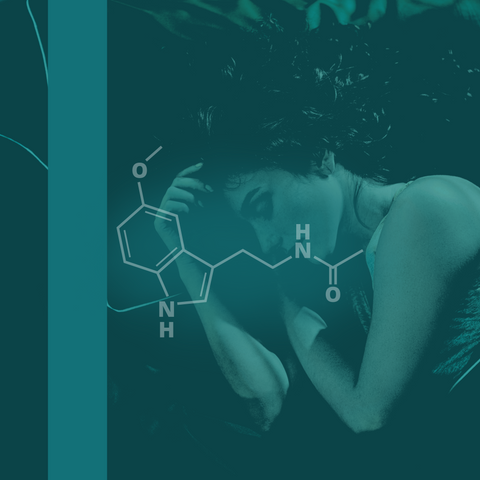Gamma-aminobutyric acid (GABA) is an inhibitory neurotransmitter that is naturally present in the central nervous system. It plays a crucial role in the regulation of neuronal excitability and balance between excitatory and inhibitory activity of the brain. GABA binds to two types of receptors, ionotropic receptors (GABA-A and GABA-C) and metabotropic receptors (GABA-B) [1]. Its binding to ionotropic receptors triggers the opening of chloride ion channels present in the neural membrane. The following influx of chloride ions hyperpolarizes the neuron, reducing its excitability by decreasing its chances of getting activated by an action potential. GABA-B receptor inhibition or activation upon GABA binding results in the modulation of ion channels, neurotransmitter release, and membrane potentials, allowing a fine-tuning of the neuron activity in the brain [2].
If you want to take a deeper dive into GABA, check out our in-depth guide
here. In this article, we'll focus on the symptoms and causes of GABA deficiency. However, if you're aware of these signs and would instead like to find ways to help increase GABA levels naturally, or if you're curious about whether or not GABA supplements work, read
here.
GABA synthesis and metabolism
GABA is synthesized from glutamate, which is a principal excitatory neurotransmitter produced from glutamine through glutaminase activity, by the glutamate decarboxylase (GAD) enzyme through the GABA pathway. Both GAD variants, GAD65 and GAD67, require pyridoxal-5′-phosphate, the active form of vitamin B6, as an allosteric cofactor to decarboxylate glutamate [3].
Another enzyme, known as GABA transaminase (GABA-T), clears released GABA from the synapses by converting it back into glutamate [4].
Both GAD and GABA-T are highly expressed in the brain. Additionally, GAD is expressed in the pancreas, while GABA-T is found in the liver and to a lower extent in the pancreas and kidneys [4].
GABA roles in humans
In the brain, GABA participates in the balance-controlling cognitive functions and emotional responses along with glutamate, and this regulation is influenced by neuromodulators such as dopamine and acetylcholine [2]. GABA is also known for its calming effects and ability to induce sleepiness when activating GABA-A receptors [5]. GABA also inhibits unwanted motor signals and is involved in the maintenance of respiratory rate from the medulla. In the spinal cord, GABA neurons help with the excitatory proprioceptive signals and the integration of sensory information to allow smooth movements [6-8]. Finally, in the pancreas, GABA inhibits alpha cells, stimulates beta-cell growth, and converts alpha cells into beta cells [6]. Although GABA is also found in other organs, its significance and function at these other sites are still unclear and require further studies.
If you're curious about how GABA works with sleep hormones such as melatonin, serotonin, and others, read here.
Clinical significance of GABA
Numerous drugs can modulate the GABAergic system. For example, benzodiazepines are agonists (activators) of GABA-A receptors. They are used to treat epilepsy, rapid eye movement sleep disorders, alcohol withdrawal, essential tremor, and muscle spasticity [9].
Symptoms of low levels of GABA
Disruptions in the balance between excitatory and inhibitory transmission are implicated in several psychiatric disorders, including anxiety disorders, depression, and schizophrenia [2]. Deficit in GABA or low GABA levels is associated with insomnia, irritability, attention deficit hyperactivity disorder, and epilepsy. It may also cause dystonia and spasticity, and the lack of GABA is partially responsible for the motor symptoms in Huntington's and Parkinson’s disease [4,9,10].
Causes of GABA deficiency
GABA deficiency can result from various factors impacting its synthesis, metabolism, or receptor function. A deficit in vitamin B6 can disrupt GABA levels as its activated form, pyridoxine, is a crucial co-factor for GAD to synthesize GABA [7]. Similarly, inadequate intake of other nutrients required for GABA synthesis or receptor function, such as glutamate (GABA precursor), magnesium [11], or zinc [12], can contribute to GABAergic system deficiency. Stress and depression also alter GABA transmission. Several studies (in humans and rodents) have reported alterations in GAD expression, lower GABA levels, and fewer GABA-A and GABA-B receptors in specific regions of the brain [10,13,14].
Chronic alcohol consumption can also disrupt GABA neurotransmission. Alcohol initially increases GABA activity, leading to sedative effects, but chronic use can downregulate GABA receptors, resulting in GABA deficiency when alcohol is withdrawn [15-18].
Finally, infections can also disrupt GABA levels. Toxoplasma gondii, a protozoan parasite, uses GABA as a carbon source for its metabolism and interferes with the signaling of GABA in the brain. Experiments in mice showed that these parasite-induced changes in GAD67 distribution resulted in the development of spontaneous seizures. These data suggest that seizures and other neurological complications seen in human toxoplasmosis patients are due, at least in part, to changes in GABAergic signaling [19]. Post-acute COVID-19 syndrome, also known as Long-COVID, is also linked to reduced GABA levels, which correlate with depression and poor sleep quality in affected patients [20].
Conclusion
GABA plays a critical role in the brain and has potential implications for mental and physical health. Factors causing GABA deficiency can individually or collectively contribute to alterations of the GABAergic system leading to neurological symptoms.
If you're looking for effective ways to increase GABA in your brain naturally, you might want to consider two superb options that have been carefully calibrated by the 4 physicians at Troscriptions — Tro Zzz and Tro Calm.
Tro Zzz is more than just a sleep aid — it's our
buccal troche that utilizes the collective power of science, nature, and your GABA system to deliver the restful sleep you've been dreaming of. Not only does it aid in falling asleep faster, but it also ensures that you stay asleep longer, and if you happen to wake up, you can easily fall back asleep. With Tro Zzz, you wake up with renewed vitality, ready to seize the day.
Tro Calm will help you take the edge off, chill out, and quiet your mind. It's designed to alleviate stress and reduce anxiousness while promoting calm productivity and focus. All 4 ingredients directly or indirectly modulate the brain’s GABAergic system.
References
[1] Hill, D.R. and Bowery, N.G. (1981) 3H-baclofen and 3H-GABA bind to bicuculline-insensitive GABAB sites in rat brain. Nature, 290, 149–52. https://doi.org/10.1038/290149a0
[2] Tsuboi, D., Nagai, T., Yoshimoto, J. and Kaibuchi, K. (2024) Neuromodulator regulation and emotions: insights from the crosstalk of cell signaling. Frontiers in Molecular Neuroscience, 17, 1376762. https://doi.org/10.3389/fnmol.2024.1376762
[6] Wang, Q., Ren, L., Wan, Y. and Prud’homme, G.J. (2019) GABAergic regulation of pancreatic islet cells: Physiology and antidiabetic effects. Journal of Cellular Physiology, 234, 14432–44. https://doi.org/10.1002/jcp.28214
[7] Tong, Y. (2014) Seizures caused by pyridoxine (vitamin B6) deficiency in adults: A case report and literature review. Intractable & Rare Diseases Research, 3, 52–6. https://doi.org/10.5582/irdr.2014.01005
[8] Raymond, L.A. (2017) Striatal synaptic dysfunction and altered calcium regulation in Huntington disease. Biochemical and Biophysical Research Communications, 483, 1051–62. https://doi.org/10.1016/j.bbrc.2016.07.058
[9] Fogaça, M.V. and Duman, R.S. (2019) Cortical GABAergic Dysfunction in Stress and Depression: New Insights for Therapeutic Interventions. Frontiers in Cellular Neuroscience, 13, 87. https://doi.org/10.3389/fncel.2019.00087
[10] Jewett, B.E. and Sharma, S. (2024) Physiology, GABA. StatPearls, StatPearls Publishing, Treasure Island (FL).
[12] Takeda, A., Minami, A., Seki, Y. and Oku, N. (2004) Differential effects of zinc on glutamatergic and GABAergic neurotransmitter systems in the hippocampus. Journal of Neuroscience Research, 75, 225–9. https://doi.org/10.1002/jnr.10846
[13] Houtepen, L.C., Schür, R.R., Wijnen, J.P., Boer, V.O., Boks, M.P.M., Kahn, R.S. et al. (2017) Acute stress effects on GABA and glutamate levels in the prefrontal cortex: A 7T 1H magnetic resonance spectroscopy study. NeuroImage: Clinical, 14, 195–200. https://doi.org/10.1016/j.nicl.2017.01.001
[14] Hasler, G., Van Der Veen, J.W., Tumonis, T., Meyers, N., Shen, J. and Drevets, W.C. (2007) Reduced Prefrontal Glutamate/Glutamine and γ-Aminobutyric Acid Levels in Major Depression Determined Using Proton Magnetic Resonance Spectroscopy. Archives of General Psychiatry, 64, 193. https://doi.org/10.1001/archpsyc.64.2.193
[16] Prisciandaro, J.J., Schacht, J.P., Prescot, A.P., Renshaw, P.F., Brown, T.R. and Anton, R.F. (2019) Brain Glutamate, GABA, and Glutamine Levels and Associations with Recent Drinking in Treatment‐Naïve Individuals with Alcohol Use Disorder Versus Light Drinkers. Alcoholism: Clinical and Experimental Research, 43, 221–6. https://doi.org/10.1111/acer.13931
[17] Kirkland, A.E., Browning, B.D., Green, R., Leggio, L., Meyerhoff, D.J. and Squeglia, L.M. (2022) Brain metabolite alterations related to alcohol use: a meta-analysis of proton magnetic resonance spectroscopy studies. Molecular Psychiatry, 27, 3223–36. https://doi.org/10.1038/s41380-022-01594-8
[18] Shyu, C., Chavez, S., Boileau, I. and Le Foll, B. (2022) Quantifying GABA in Addiction: A Review of Proton Magnetic Resonance Spectroscopy Studies. Brain Sciences, 12, 918. https://doi.org/10.3390/brainsci12070918
[19] Brooks, J.M., Carrillo, G.L., Su, J., Lindsay, D.S., Fox, M.A. and Blader, I.J. (2015) Toxoplasma gondii Infections Alter GABAergic Synapses and Signaling in the Central Nervous System. Weiss LM, editor. mBio, 6, e01428-15. https://doi.org/10.1128/mBio.01428-15
[20] Marinkovic, K., White, D.R., Alderson Myers, A., Parker, K.S., Arienzo, D. and Mason, G.F. (2023) Cortical GABA Levels Are Reduced in Post-Acute COVID-19 Syndrome. Brain Sciences, 13, 1666. https://doi.org/10.3390/brainsci13121666





Comments (0)
There are no comments for this article. Be the first one to leave a message!